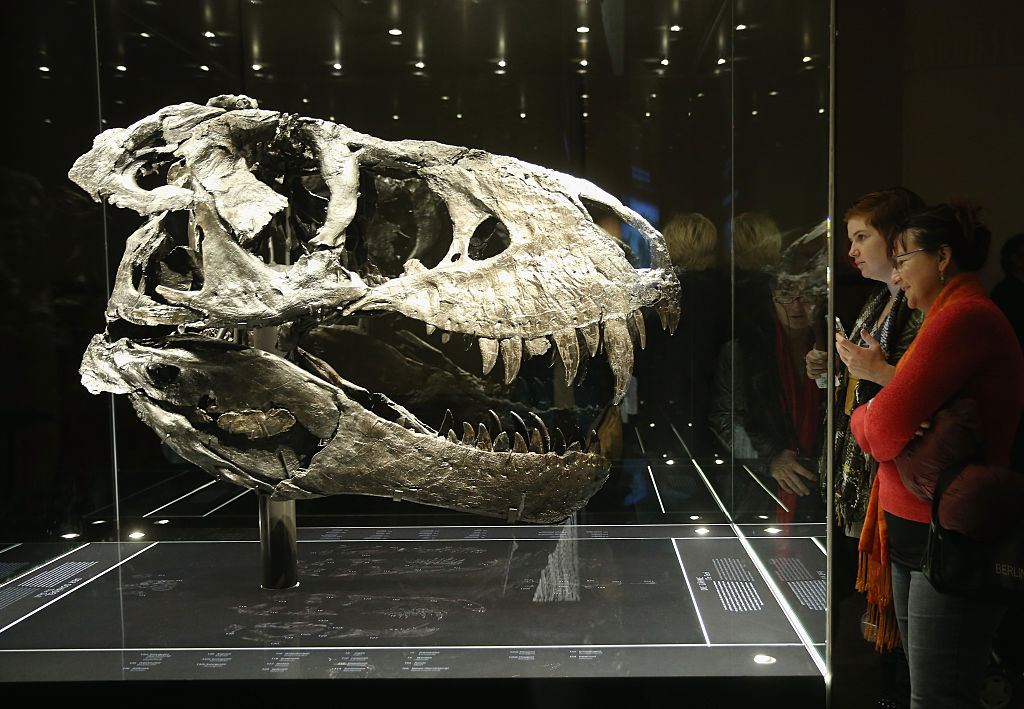
Think the modern world has a problem with what fossil fuels are doing to the atmosphere? Turns out that the fossils themselves—the dinosaurs—had it even worse. According to a new paper published in Nature, it was a problem so severe it cost them their lives.
The earthly crime scene that led to the extinction of the dinosaurs has long since been analyzed and understood. About 66 million years ago, a six-mile wide (10 km) asteroid struck the coastline of the Yucatan peninsula. The massive hit threw up a global cloud of sulfuric aerosols that cooled the planet, leading to the death of nearly 90% of the world’s land-dwelling life forms and about 10% of the relatively shallow-dwelling sea creatures. (Species that lived deeper, below 650 ft. [200 m] did not feel the cooling as much.) The scar the impact left behind is known as the Chixculub Crater—which is Mayan for “tale of the devil” and pretty much describes the damage the impact did. So case closed, right?
Not quite. For starters, investigators have long argued that the asteroid had a co-conspirator in the form of massive volcanic eruptions in a central Indian region known as the Deccan Traps, which made their own contribution to atmospheric shrouding and global cooling. A study published on July 5, also in Nature, added weight to that theory by analyzing isotopes in the fossilized shells of ocean organisms, showing two closely-spaced spikes in cooling, one attributable to the volcanoes, one to the asteroid.
But a group of Japanese investigators led by Kunio Kaiho, of the Department of earth Sciences at the Tohoku University, were never quite satisfied with the asteroid-impact part of the extinction scenario. The collision took place alright, and it didn’t do the dinos any favors, but the blame can’t go entirely—or even mostly—to the sulfur aerosols it produced. According to existing models studied by Kaiho and his colleagues, those kinds of particles would have lingered in the stratosphere for too short a time to cause enough cooling to lead to widespread death below.
What could have lingered long enough would have been black carbon—or common soot— the kind that comes from burning oil. The dinosaurs that were alive at the time of the extinction had certainly not made the jump from animal to organic waste to fossil fuel yet, but the ones that died during the Jurassic Period—up to 201 million years ago—and earlier, could have.
To determine if soot was indeed the proximate killer, Kuhio and his colleagues first collected samples in Haiti and Spain from a geological stratum known as the iridium layer. Iridium is an element uncommon on Earth but very common in asteroids and meteorites. One place it does show up on our planet is in a thin subterranean layer that corresponds to a period 66 million years ago, or precisely when the Chixculub meteorite hit. After the residue of the rock blasted into the sky, it would have precipitated down everywhere and then been covered up by natural tectonic changes. It was only much, much later that excavating humans would discover it.
The investigators analyzed the samples they collected for evidence of other substances—coronene, benzopyrene and benzopyrylene, which are all chemical markers of burning hydrocarbons like oil. The samples, as they suspected, turned out to be rich in the stuff. Some of that, they concluded, was probably produced by the raging wildfires triggered by the impact, but most was caused by the fact that when the asteroid hit, it released and ignited huge quantities of buried oil.
The exact size of the deposit that would have been struck by the rock is impossible to know, but the researchers put it at up to 6,000 teragrams, which is 6 billion kilograms or 13 billion pounds. If as little as a quarter to a half of that went up in smoke it could have led to a dimming of available sunlight by as much as 90% and caused temperatures to fall by anywhere from 18ºF to 34ºF (10°C to 18°C) in some areas.
“The rapid climate change,” the investigators wrote, “induced terrestrial extinctions followed by marine mammal extinctions over several years.”
The darkness and the chill did not last long—at least not in its most acute stages. After as little five years, the worst of it might have been over, but it would take far longer for the skies to clear completely. Still the enduring cold and the atmospheric disruptions that led to drought at some latitudes meant that the big reptilian critters were done for.
The irony, of course, is that the die-off left room for the mammals to emerge and expand. Some of those species became mildly intelligent—and one became exceedingly so, enough that it eventually learned to pump and burn oil on its own. That, the dinosaurs could tell you, is a tricky game to play.
More Must-Reads from TIME
- Why Trump’s Message Worked on Latino Men
- What Trump’s Win Could Mean for Housing
- The 100 Must-Read Books of 2024
- Sleep Doctors Share the 1 Tip That’s Changed Their Lives
- Column: Let’s Bring Back Romance
- What It’s Like to Have Long COVID As a Kid
- FX’s Say Nothing Is the Must-Watch Political Thriller of 2024
- Merle Bombardieri Is Helping People Make the Baby Decision
Write to Jeffrey Kluger at jeffrey.kluger@time.com